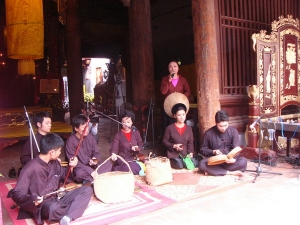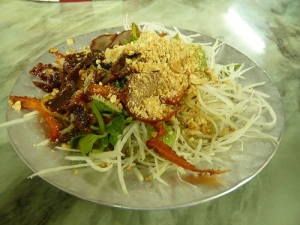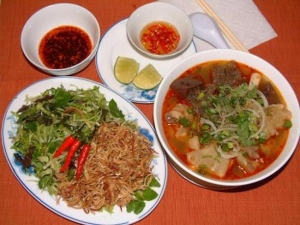"Hat Xam" returns to the big stage
The event is co-hosted by the Centre for Research, Preservation and Promotion of Vietnamese Traditional Culture and the Centre for Research, Preservation and Promotion of Vietnamese Traditional Music in an attempt to reaffirm the art’s emblematic value to Vietnamese traditional folk music.
Director of the Centre for Research, Preservation and Promotion of Vietnamese Traditional Culture, Professor Hoang Chuong, who is also general director of the performance programme, said the art was very popular in many northern localities and Hanoi during the early 20 th century.
The performance will consist of three parts, traditional Xam, contemporary Xam, and Xam in combination with other musical genres.
The event will feature numerous artists, including Thanh Ngoan, Thuy Ngan, saxophone artist Phan Anh Dung, singer Ha Linh, beat boxer Minh Kien, and the Ha Thanh Xam group.
"Green Fins" - A project on sustainable diving in Nha Trang
A local firm is offering tours that provide tourists with the chance to experience sea diving and behold pearl-yielding mollusks in the city, which is the capital of Khanh Hoa Province, according to Radio the Voice of Vietnam.
Ho Thanh Tuan, director of Hoang Gia Pearl Farming Co., told the radio that unlike most seas in the world, which host only a certain variety of pearl-yielding mollusk, scientists have detected a wide array of such varieties in Vietnam.
Tuan owns a system of pearl mollusk farms considered among the country’s largest. His farms span from the central to the southern coastline.
He has also launched tours in which tourists will enjoy diving in the sea and explore how pearl mollusks are cultivated.
Tourists can also catch the invertebrate and slice them open to get their pearls.
Tuan said his tours not only bring tourists an intriguing experience but also enhance their knowledge of pearl mollusks to keep them from being cheated into buying fake or freshwater pearls.
The tours are part of a project which provincial authorities have assigned to Tuan’s company and the Hon Tam Tourism Complex, also located in Nha Trang.
Sustainable diving

The United Nations Environment Program (UNEP), which acts as a catalyst, advocate, educator and facilitator to promote the wise use and sustainable development of the global environment, selected Nha Trang as the location for its project called “Green Fins” in 2013.
The project, worth US$26,000, is aimed at promoting the sustainable use of coral reefs and the Nha Trang ecological system, which boasts the highest concentration of tourist sea diving activity, according to the Vietnamese Ministry of Natural Resources and Environment.
The project’s members also want to establish “Green Fins” groups across Vietnam and put forward environmental policies in the country.
It is a bid to cushion the local ecological system from adverse impacts caused by sea diving, the ministry added.
Ecologically harmful activities include causing damage to coral reefs – or even breaking them while anchoring or trampling on them during sea diving – and littering in the sea.
The Nha Trang Institute of Oceanography, the overseer of the “Green Fins” project, has conducted several activities – including making sure sea diving clubs throughout the province abide by the “Green Fins” code of conduct, setting up a Green Fins Vietnam website at www.greenfins.net, and handing out leaflets to diving club owners and tourists to raise awareness of sustainable diving.
The institute is based in Nha Trang, which makes it a natural location for “Green Fins” to be implemented into the local diving community on a pilot scale before expanding into other diverse and popular diving locations in the country.
Thirteen out of 15 diving clubs in Nha Trang have joined the “Green Fins” program so far.
"Nom bo kho" - The simple dish in Hanoi
Sweet and sour grated papaya salad mixed with beef is sold in many places. However, only in Ho Hoan Kiem street can Ha Noi gourmets enjoy this traditional dish with its real taste.
In the past, there were a few stands selling this dish. Later on, more stands appeared and this dish is now popularly sold.
A portion of sweet and sour grated papaya salad includes thin sliced beef (fried and ground beef), thick beef (grilled beef), spleen, tendon (cow stomach), sauce, sour and sweet vinegar, garlic vinegar and roasted peanuts. The unique feature of this kind of salad lies in the four typical tastes: sour, peppery, salty, sweet and not too fatty.
"Pho" and "Bun bo Hue" - The taste of home in Paris
In Ha Noi, I don't limit myself to eating pho and rice. But after navigating through France's notorious railway strikes for days, exhausted from walking, all I wanted was a hot bowl of noodle soup.
We began our European travels with sandwiches, churros and paella, followed by quiche and salad, crepes and galletes. When we got to Paris, however, we started to crave Vietnamese food.
At the Opera Metro station in the heart of Paris, we spotted a white chalkboard advertising a Vietnamese restaurant. It was a strange location, as most Vietnamese dining places are located in the 13th arrondisement.

Pho (Bowl of noodle soup)
Inside, the dimly lit eatery was unremarkable. There was a small altar and signs in Chinese characters. As in Viet Nam, where green plastic pine leaf decorations and ABBA's "Happy New Year" song pop up all year round, Christmas decorations adorned the ceiling. The server spoke only French and English but managed to pronounce the dishes correctly in Vietnamese.
We ordered one bowl of pho and another of bun bo Hue, which is made with rice vermicelli rather than pho noodles, although the difference between these soups is far more nuanced. While pho is subtly flavoured, bun bo Hue has the strong flavour of shrimp paste and lemongrass due to its origins in the former royal capital city of Hue. In Viet Nam, these two dishes are never served in the same eatery, because the stocks used to make them are so different. But in Paris, I was sure that the stock for these two distinctive dishes came from a single pot!

Bun bo Hue
A Vietnamese friend who lived in Berlin for more than 20 years once took me around the Dong Xuan market there, trying to make the case that the pho soup's quality was far superior to the Vietnamese version. "Look at the bones! The beef bones here are very clean and when people make the stock for pho, they use lots of good bones with marrow, so the stock tastes very good, even better than the stock you have in Viet Nam."
Similarly, when my Vietnamese friends living abroad come home to Ha Noi, I take them out to have pho or bun thang, a Ha Noi-style rice vermicelli soup with shredded chicken and pork sausage. But sometimes they tell me that the pho here does not taste as good as the soup they ate abroad.
Sure, the bones may be cleaner and better overseas, but the stock must also be made with authentic ingredients. Pungent shrimp paste baked in a banana leaf over charcoal fire may not sound very appetising to some western readers, but it's an integral ingredient for bun bo Hue. Pho gia truyen, which translates to "traditional family pho," comes from Nam Dinh province in the north, where families have their own secret recipes that are passed down by mothers to daughters-in-law.
However, maybe I was being too picky. In Paris, could I really expect authentic flavour like the soup in Ha Noi's Old Quarter?
A Vietnamese saying goes, "One bite when one's hungry equals a package when one's full." The meal by the Paris Opera might not have been the most delicious, but it was at least a satisfying taste of home.









































































































